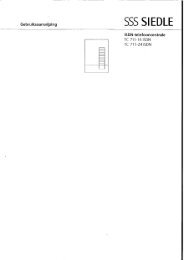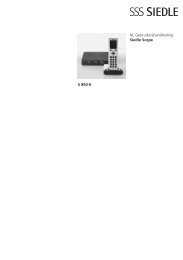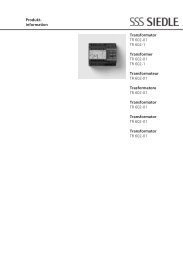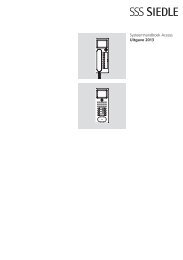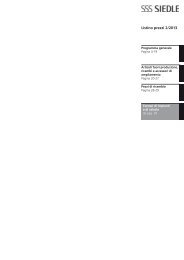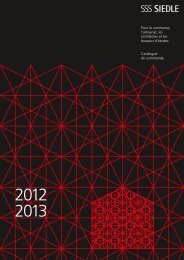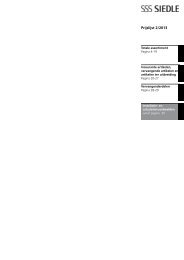System Manual Access Issue 2013 - Siedle
System Manual Access Issue 2013 - Siedle
System Manual Access Issue 2013 - Siedle
You also want an ePaper? Increase the reach of your titles
YUMPU automatically turns print PDFs into web optimized ePapers that Google loves.
<strong>System</strong> description<br />
Safety remarks<br />
<strong>Siedle</strong> <strong>Access</strong> is a powerful communication<br />
system based on<br />
groundbreaking IP technology.<br />
Communication is enabled both<br />
for audio and video and also for<br />
switching, control and signalling.<br />
The ideal field of application for the<br />
system is either in large properties<br />
or in any type of facility entailing<br />
complex technical requirements. Due<br />
to the central administration of the<br />
entire system, the work involved in<br />
commissioning and maintenance is<br />
kept to a minimum. The installation<br />
is based on network technology,<br />
making it extremely open for further<br />
expansion.<br />
Commercial and private applications<br />
can be mixed or combined at will.<br />
Technology parks can be connected<br />
to administration or training centres<br />
under a single cohesive system, even<br />
across different buildings, while still<br />
retaining their own independent<br />
functions.<br />
Generally speaking, a distinction is<br />
drawn between the door area and<br />
the protected local area network<br />
(LAN). A detailed description of<br />
these two areas is provided in the<br />
section <strong>System</strong> structure/conductor<br />
material.<br />
Electrical voltage<br />
Mounting, installation and servicing<br />
work on electrical devices may only<br />
be performed by a suitably qualified<br />
electrician. Failure to observe this<br />
regulation could result in the risk of<br />
serious damage to health or fatal<br />
injury due to electric shocks.<br />
Electrostatic charging<br />
As a result of electrostatic charging,<br />
direct contact with the circuit board<br />
can result in destruction of the<br />
device. Direct contact with the circuit<br />
board must therefore be avoided.<br />
• When working at the device,<br />
observe the remarks relating to<br />
mains cut-off.<br />
• Observe the DIN EN 60065<br />
standard! When establishing the<br />
electronic connection, observe the<br />
requirements of VDE 0805 or EN<br />
60950.<br />
• The building installation must<br />
include an all-pole mains switch<br />
with a contact separation of at least<br />
3 mm.<br />
• Ensure maximum fusing of 16A for<br />
the mains connection in the building<br />
installation.<br />
• When planning large-scale<br />
(complex) systems, the distributor<br />
space required for the switch panel<br />
mounting devices must be taken<br />
into consideration in the distributor<br />
planning process.No external voltages<br />
>30 V AC/DC may be applied<br />
to system users.<br />
Devices with 230 V connection<br />
In accordance with DIN VDE 0100<br />
part 410, section 411.1.3 attention<br />
must be paid to ensuring a safe<br />
separation between system lines and<br />
the mains voltage; i.e. system and<br />
mains cores must not be permitted<br />
to touch! The system line cable<br />
(extra-low safety voltage) must be<br />
stripped back by the minimum possible.<br />
During the update process, the<br />
power supply to the devices must<br />
not be interrupted, as this can result<br />
in damage. In this case, a repeat<br />
update is no longer possible, and the<br />
devices will have to be sent in for<br />
repair.<br />
3




